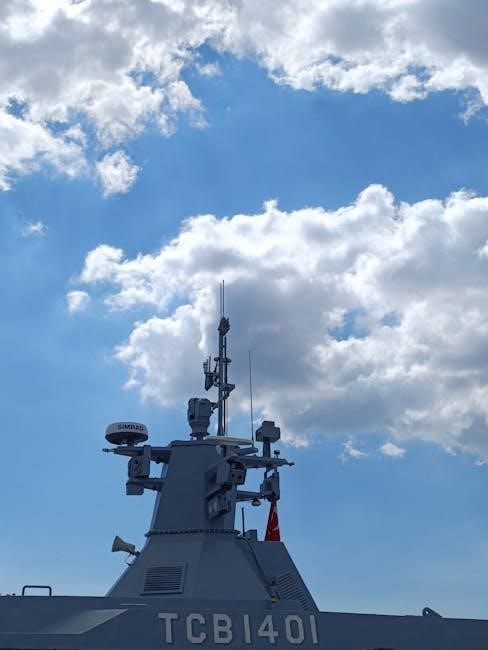The Navy Correspondence Manual is a crucial resource developed by the Department of the Navy to standardize communication processes․ It provides guidelines for drafting‚ formatting‚ and managing official correspondence‚ ensuring clarity‚ professionalism‚ and efficiency in all naval communications․ Available as a PDF‚ it serves as the primary reference for maintaining consistent and effective communication across the Department of the Navy․
1․1․ Purpose of the Manual
The Navy Correspondence Manual serves as a comprehensive guide to standardize communication across the Navy and Marine Corps․ Its primary purpose is to ensure clarity‚ consistency‚ and professionalism in all official correspondence․ By providing detailed guidelines‚ the manual aims to enhance the effectiveness of written and electronic communication․ It outlines the proper structure‚ format‚ and tone for various types of correspondence‚ ensuring compliance with naval traditions and federal regulations․ This standardized approach fosters clear understanding‚ reduces errors‚ and supports the efficient execution of naval operations and mission objectives․
1․2․ Scope and Applicability
The Navy Correspondence Manual is applicable to all official correspondence within the Department of the Navy‚ including the U․S․ Navy and Marine Corps․ It governs both written and electronic communications‚ ensuring uniformity in style‚ format‚ and terminology․ The manual applies to active duty‚ reserve‚ and civilian personnel‚ as well as contractors engaged in naval activities․ Its scope extends to formal letters‚ memos‚ reports‚ and digital communications‚ providing clear guidelines for preparation‚ submission‚ and dissemination․ Compliance with the manual is mandatory to maintain professionalism‚ clarity‚ and adherence to naval traditions and federal regulations․
1․3․ Importance of Standardized Communication
Standardized communication is critical for ensuring clarity‚ professionalism‚ and efficiency in naval operations․ It fosters effective command and control by eliminating ambiguity in orders and reports․ Consistent messaging aligns with the Navy’s commitment to precision and discipline‚ promoting a professional image․ Standardization also enhances operational decision-making by providing clear and concise information․ It ensures compliance with regulations and maintains the integrity of naval traditions․ By adhering to established guidelines‚ personnel uphold the Navy’s values and contribute to seamless coordination across units․ This consistency is vital for both internal operations and external interactions‚ reinforcing trust and credibility;

Key Features of the Navy Correspondence Manual
The manual provides standardized formats‚ clarity guidelines‚ proper terminology‚ and electronic communication standards․ It ensures consistency‚ professionalism‚ and efficiency in naval correspondence․
2․1․ Standardized Formats for Correspondence
The manual establishes uniform templates and structures for official correspondence‚ ensuring consistency across all communications․ It includes specific formats for letters‚ memos‚ and reports‚ with detailed guidance on headings‚ salutations‚ and closures․ Standardized reference lines‚ dates‚ and signature blocks are emphasized to maintain professionalism and clarity․ These formats are designed to streamline communication‚ reduce errors‚ and enhance readability․ By adhering to these guidelines‚ personnel can produce documents that align with Navy standards‚ fostering a professional and cohesive image across the organization․ This section is critical for maintaining uniformity in all naval correspondence․
2․2․ Guidelines for Clarity and Conciseness
The manual emphasizes the importance of clear and concise communication to ensure messages are understood quickly and accurately․ It provides guidelines to avoid unnecessary complexity‚ jargon‚ and ambiguity․ Personnel are encouraged to use straightforward language‚ active voice‚ and precise terminology․ Each paragraph should focus on a single idea‚ and sentences should be concise․ The manual also advises against redundant phrases and promotes the use of bullet points or numbered lists for complex information․ These guidelines help ensure that naval correspondence is efficient‚ professional‚ and free from misinterpretation‚ aligning with the Navy’s commitment to effective communication․
2․3․ Proper Use of Terminology and Abbreviations
The manual stresses the correct use of terminology and abbreviations to maintain consistency and clarity in naval correspondence․ It provides an extensive glossary of approved terms and definitions to ensure uniform understanding across all communications․ Personnel are required to use only authorized abbreviations‚ avoiding informal or ambiguous shorthand․ Proper terminology aligns with official Navy standards‚ preventing misinterpretation and ensuring professionalism․ The manual also highlights the importance of consistency in abbreviations to avoid confusion‚ especially in operational contexts where precise communication is critical․ This ensures all correspondence meets the Navy’s high standards for accuracy and effectiveness․
2․4․ Electronic Communication Standards
The manual establishes clear standards for electronic communication to ensure efficiency and security․ It outlines protocols for email‚ instant messaging‚ and document sharing‚ emphasizing the use of approved platforms․ Encryption and secure networks are mandated for sensitive information․ The manual also provides guidelines for digital signatures and authentication processes․ Standardized email templates and formats are included to maintain professionalism and clarity․ Additionally‚ it addresses proper practices for attaching documents and managing electronic records․ Compliance with these standards ensures secure‚ consistent‚ and professional communication across all naval operations․ Adherence is critical to maintaining operational integrity and data protection․

Historical Background and Development
The Navy Correspondence Manual traces its origins to the early 20th century‚ evolving to standardize communication across naval operations․ It was formally established by the Secretary of the Navy to ensure clarity and consistency in official correspondence․ Over the years‚ it has undergone revisions to reflect changing communication needs and technological advancements․ The manual’s development is closely tied to the Navy’s operational requirements‚ ensuring effective and secure communication practices․ Its historical evolution underscores its critical role in maintaining naval traditions and professionalism․
3․1․ Evolution of Naval Correspondence Standards
The evolution of naval correspondence standards reflects the Navy’s commitment to clear and effective communication․ Established by SECNAVINST 5216․5D‚ these standards ensure consistency across all official documents․ Over time‚ the manual has transitioned from manual processes to automated systems‚ enhancing efficiency․ Key updates include standardized templates‚ digital signatures‚ and secure communication protocols․ The emphasis on clarity and brevity aligns with operational needs‚ ensuring swift decision-making․ By adapting to technological advancements‚ the manual remains a cornerstone of naval professionalism‚ fostering precise and secure correspondence․ Regular updates ensure alignment with federal regulations and emerging challenges․ This evolution underscores its enduring relevance․
3․2․ Key Updates in Recent Editions
Recent editions of the Navy Correspondence Manual have introduced significant updates to align with modern communication needs․ These include enhanced digital transformation guidelines‚ such as the adoption of electronic signatures and secure communication protocols․ Additionally‚ updated templates and formatting standards have been incorporated to improve clarity and efficiency․ The manual now places greater emphasis on compliance with federal regulations and cybersecurity requirements․ These updates reflect the Navy’s commitment to maintaining professionalism and precision in official correspondence while adapting to technological advancements and operational demands․ They ensure that the manual remains a reliable resource for personnel․
3․3․ The Role of SECNAVINST 5216․5D
The SECNAVINST 5216․5D plays a pivotal role in governing naval correspondence by providing authoritative guidance on standardized communication practices․ It ensures alignment with federal regulations and Department of the Navy policies‚ emphasizing clarity‚ professionalism‚ and compliance․ This instruction mandates the use of specific formats‚ terminology‚ and procedures‚ ensuring consistency across all official correspondence․ It also addresses electronic communication standards‚ record-keeping requirements‚ and security protocols․ By adhering to SECNAVINST 5216․5D‚ personnel ensure that their correspondence meets legal‚ administrative‚ and operational expectations‚ fostering efficient and secure communication within the Navy and Marine Corps․ This instruction is integral to maintaining the integrity of official documents․

Structure of the Navy Correspondence Manual
The manual is organized into clear chapters and appendices‚ providing structured guidance for drafting‚ formatting‚ and submitting official correspondence efficiently․
4․1․ Organization of the Document
The Navy Correspondence Manual is divided into logical chapters‚ each addressing specific aspects of naval communication․ It begins with an introduction to the manual’s purpose and scope‚ followed by detailed sections on correspondence formats‚ clarity‚ terminology‚ and electronic communication standards․ The document is further organized into appendices that provide templates‚ examples‚ and references‚ ensuring users can easily access practical tools․ This structured approach allows personnel to navigate the manual efficiently‚ locating relevant information quickly․ Regular updates ensure the manual aligns with current policies and technological advancements‚ maintaining its relevance and effectiveness․
4․2․ Chapters and Appendices Overview
The Navy Correspondence Manual is structured into clear chapters‚ each focusing on distinct aspects of naval correspondence․ The chapters cover core topics such as standardized formats‚ clarity in writing‚ and proper terminology use․ Appendices provide supplementary resources‚ including sample templates‚ reference materials‚ and detailed examples to support practical application․ This user-friendly organization ensures that personnel can quickly locate specific guidance‚ from formatting official letters to understanding electronic communication protocols․ The manual’s appendices also include cross-references to related sections‚ enhancing navigation and comprehension․ This comprehensive structure makes the manual an indispensable resource for effective naval communication․
4․3․ References and Supplements
The Navy Correspondence Manual includes detailed references and supplements to ensure comprehensive guidance․ These sections provide cross-references to key regulations‚ such as SECNAVINST 5216․5D‚ and other official documents․ Supplements offer additional resources‚ including style guides‚ terminology lists‚ and examples of correspondence formats․ Together‚ these elements enhance the manual’s utility‚ ensuring users have access to all necessary information for crafting precise and professional communications․ This integrated approach supports consistency across all naval correspondence‚ aligning with broader Department of the Navy standards․ The references and supplements are regularly updated to reflect current practices and policies․

Marine Corps Supplement to the Manual
The Marine Corps Supplement‚ MCO 5216․20‚ provides tailored guidance for Marine Corps personnel‚ ensuring alignment with Navy standards while addressing unique Marine Corps requirements and terminology․
5․1․ MCO 5216․20 Overview
The Marine Corps Order (MCO) 5216․20 serves as the official supplement to the Navy Correspondence Manual‚ providing specific guidance tailored to Marine Corps personnel․ This document outlines the standardized procedures for preparing and submitting correspondence within the Marine Corps‚ ensuring alignment with broader Navy protocols while addressing unique Marine-specific requirements․ It covers formats for official letters‚ reports‚ and messages‚ emphasizing clarity‚ brevity‚ and proper terminology․ MCO 5216․20 also includes directives on the use of abbreviations‚ acronyms‚ and specific marine terminology‚ ensuring consistency and professionalism in all communications․ This supplement is essential for maintaining uniformity across the Marine Corps․
5․2․ Specific Guidance for Marine Corps Personnel
The Marine Corps supplement‚ MCO 5216․20‚ provides tailored guidance for Marine personnel‚ aligning with the Navy Correspondence Manual while addressing unique Marine Corps requirements․ It emphasizes clarity‚ brevity‚ and precision in communication‚ reflecting Marine Corps values․ Personnel are instructed to follow specific formats for operational correspondence‚ including mission reports and orders․ The supplement also highlights the importance of maintaining professionalism and adherence to both Navy and Marine Corps standards․ This ensures seamless integration and consistency across joint operations‚ fostering effective communication and interoperability․
5․3․ Differences from the Navy Manual
The Marine Corps Supplement to the Navy Correspondence Manual incorporates unique guidance tailored to Marine Corps operations and traditions․ While aligning with the Navy’s framework‚ it includes distinct chapters on Marine-specific protocols‚ such as unit-specific communication formats and mission-oriented correspondence․ Additionally‚ the supplement emphasizes Marine Corps jargon and operational terminology‚ ensuring clarity within Marine contexts․ It also provides examples and templates specific to Marine operations‚ differing from the Navy’s more generalized approach․ These adjustments ensure the supplement meets the unique needs of Marine Corps personnel while maintaining overall consistency with Navy standards․

Implementing the Manual in Daily Operations
Implementing the manual involves integrating standardized procedures into daily tasks‚ ensuring conformity with guidelines through regular training and digital tools‚ and maintaining consistency across all communications for operational efficiency and clarity․
6․1․ Training and Education Programs
The Navy Correspondence Manual emphasizes the importance of training and education programs to ensure personnel master standardized communication practices․ These programs are designed to familiarize sailors and officers with the manual’s guidelines‚ fostering consistency and professionalism in official correspondence․ Training typically includes workshops‚ online modules‚ and hands-on exercises‚ covering topics like proper formatting‚ terminology‚ and electronic communication standards․ Command-specific sessions are also conducted to address unique operational needs․ The goal is to equip personnel with the skills to draft clear‚ concise‚ and compliant correspondence‚ reducing errors and enhancing overall efficiency․ Regular updates ensure alignment with the latest edition of the Navy Correspondence Manual PDF․
6․2․ Tools and Resources for Effective Correspondence
The Navy Correspondence Manual provides a range of tools and resources to ensure effective communication․ These include standardized templates‚ style guides‚ and checklists to streamline correspondence preparation․ The manual also references official Navy websites and portals where personnel can access updated forms and guidelines․ Additionally‚ training modules and workshops are available to enhance writing skills and adherence to protocols․ Practical examples and case studies are included to illustrate best practices‚ making it easier for personnel to apply the guidelines in real-world scenarios․ These resources collectively promote clarity‚ accuracy‚ and professionalism in naval correspondence․
6․3․ Best Practices for Consistency
Consistency in naval correspondence ensures clarity‚ professionalism‚ and adherence to standards․ Always use standardized templates and formatting guidelines outlined in the manual․ Avoid deviations in terminology‚ abbreviations‚ and structural elements․ Regularly review and update correspondence to reflect current policies and procedures․ Incorporate feedback from training programs and peer reviews to maintain uniformity․ Ensure all personnel involved in drafting correspondence are familiar with the manual’s requirements․ Proofread documents to eliminate errors and align with established styles․ Consistency fosters effective communication‚ enhancing the Navy’s operational efficiency and professional image․ Examples from the manual can serve as benchmarks for achieving this goal․

Legal and Administrative Considerations
The Navy Correspondence Manual outlines critical legal and administrative guidelines to ensure secure‚ compliant‚ and efficient communication․ Adhering to these standards prevents legal issues and maintains operational integrity․
7․1․ Records Management Requirements
The Navy Correspondence Manual emphasizes the importance of proper records management to ensure accountability‚ transparency‚ and compliance with federal regulations․ Personnel must adhere to established retention schedules for correspondence‚ with specific guidelines for both physical and electronic records․ Documents must be stored securely‚ with access restricted to authorized individuals․ Proper disposal methods‚ including shredding or secure digital deletion‚ are mandated to protect sensitive information․ Additionally‚ records must be maintained in accordance with the National Archives and Records Administration (NARA) standards and SECNAVINST 5216․5D directives to ensure historical preservation and operational continuity․
7․2․ Security and Confidentiality Guidelines
The Navy Correspondence Manual emphasizes stringent security and confidentiality measures to safeguard sensitive information․ All correspondence must adhere to classification levels‚ ensuring only authorized personnel access restricted data․ Proper marking of documents with classifications like UNCLASSIFIED‚ CONFIDENTIAL‚ SECRET‚ and TOP SECRET is mandatory․ Electronic communications must use encrypted platforms‚ and physical documents should be stored securely․ Personnel are required to report breaches immediately‚ and regular training ensures compliance with federal regulations․ These guidelines protect national security and maintain public trust in naval operations․ Adherence is non-negotiable to prevent unauthorized disclosure and potential threats to operational integrity․
7․3․ Compliance with Federal Regulations
The Navy Correspondence Manual ensures adherence to federal regulations‚ maintaining legal and administrative integrity․ Compliance with the Freedom of Information Act (FOIA) and the Privacy Act is emphasized to protect sensitive information․ Personnel must follow guidelines for handling classified data and ensure all correspondence aligns with federal standards․ Non-compliance can result in legal consequences or reputational damage․ The manual provides detailed instructions to help personnel navigate these requirements effectively‚ ensuring transparency and accountability in all communications․

Digital Transformation in Naval Correspondence
The Navy Correspondence Manual embraces digital transformation through electronic signatures‚ enhancing efficiency and security in official communications․ Secure digital platforms ensure confidentiality and integrity of sensitive information․ Advances in digital tools streamline correspondence processes‚ aligning with modern naval operations․
8․1․ Adoption of Electronic Signatures
The adoption of electronic signatures in naval correspondence has significantly streamlined processes‚ ensuring security and efficiency․ The Navy Correspondence Manual pdf outlines procedures for using digital signatures‚ aligning with federal regulations like the E-SIGN Act․ This shift reduces paperwork and accelerates document workflows․ Electronic signatures are verified through encrypted technologies‚ maintaining authenticity and integrity․ The manual emphasizes standardization in digital practices‚ ensuring all personnel adhere to strict protocols․ This modernization supports the Navy’s goal of efficient‚ secure‚ and transparent communication‚ fostering accountability and compliance across operations․
8․2․ Secure Communication Platforms
The Navy Correspondence Manual emphasizes the critical role of secure communication platforms in safeguarding sensitive information․ These platforms utilize advanced encryption protocols to protect data integrity and confidentiality․ Authentication mechanisms‚ such as multi-factor authentication‚ ensure only authorized personnel access classified materials․ Additionally‚ these systems are designed to comply with federal information security standards‚ mitigating risks of cyber threats․ Regular monitoring and updates are mandated to maintain security posture․ By leveraging these platforms‚ the Navy ensures seamless and secure exchange of official correspondence‚ aligning with its commitment to operational excellence and national security․
8․3․ Future Trends in Naval Communication
The future of naval communication will likely emphasize advanced technologies such as AI-driven analytics‚ quantum computing‚ and blockchain for secure data transmission․ Automation will streamline correspondence processes‚ reducing errors and enhancing efficiency․ The integration of 5G networks and next-gen satellite systems will enable faster‚ more reliable communication․ Additionally‚ the adoption of augmented reality (AR) and virtual reality (VR) tools could revolutionize training and operational planning․ These innovations will ensure the Navy remains at the forefront of secure‚ efficient‚ and adaptable communication systems‚ aligning with its mission to maintain global maritime superiority․

Practical Application and Examples
The Navy Correspondence Manual provides practical templates and real-life scenarios to guide personnel in drafting clear‚ concise‚ and professional correspondence‚ ensuring operational efficiency and standardized communication․
9․1․ Sample Templates and Formats
The Navy Correspondence Manual provides standardized templates to ensure consistency in official communication․ These templates include formats for memos‚ letters‚ reports‚ and messages‚ each designed to meet specific purposes․ They are structured with clear headers‚ footers‚ salutations‚ and closing sections․ Personnel can access these templates directly from the manual‚ ensuring compliance with formatting requirements․ Using these templates helps maintain professionalism and clarity‚ reducing errors and saving time․ Examples include formal memorandum formats for official decisions and casual message formats for routine updates․ These resources are essential for drafting correspondence that aligns with naval standards․
9․2․ Common Scenarios and Solutions
Navy personnel often encounter scenarios requiring precise communication․ For instance‚ drafting an urgent request for supplies or responding to formal inquiries․ The manual offers solutions by providing templates and checklists to ensure clarity and compliance․ Another scenario involves addressing multiple addressees‚ where the manual recommends using standardized salutations and organizing content logically․ Additionally‚ handling confidential information requires adhering to encryption guidelines outlined in the manual․ By following these solutions‚ personnel can maintain professionalism and efficiency in their correspondence‚ aligning with the Navy’s communication standards․
9․3․ Case Studies of Effective Correspondence
Real-world examples highlight the effectiveness of the Navy Correspondence Manual․ One case involved an aircraft carrier squadron that streamlined its operational reports‚ reducing errors by 30% after adopting standardized formats․ Another example is a submarine command that improved response times by 25% through clear‚ concise messaging․ These scenarios demonstrate how adherence to the manual enhances efficiency‚ ensures compliance‚ and supports mission success․ By following guidelines‚ personnel achieved consistent communication‚ fostering better collaboration and decision-making across units․ These case studies underscore the manual’s practical value in real operations․

Troubleshooting Common Errors
Troubleshooting common errors in navy correspondence involves identifying and correcting grammatical‚ formatting‚ and procedural mistakes․ Proper training and adherence to guidelines ensure accuracy and professionalism in communication․
- Grammatical errors can undermine clarity and credibility․
- Formatting issues may lead to non-compliance with standards․
- Addressing recipient concerns promptly maintains professionalism․
Regular reviews and feedback loops help mitigate recurring mistakes․
10․1․ Avoiding Grammatical and Stylistic Mistakes
The Navy Correspondence Manual emphasizes the importance of clear and precise communication by avoiding grammatical and stylistic errors․ It recommends using tools like style guides and proofreading checklists to ensure accuracy․ Personnel are encouraged to follow standardized formats to maintain consistency․ The manual also highlights the need for concise language‚ avoiding jargon unless necessary․ Proper use of punctuation and capitalization is stressed to prevent misinterpretation․ Regular training and reviews are suggested to refine writing skills and adhere to established guidelines‚ ensuring professional and effective correspondence across all naval operations․
10․2․ Correcting Formatting Issues
Formatting issues in naval correspondence can undermine professionalism and clarity․ The manual emphasizes consistency in margins‚ fonts‚ and spacing․ Personnel should ensure headers‚ footers‚ and page numbers align with specified guidelines․ Proofreading is crucial to detect misalignments or improper indentations․ Electronic templates provided in the manual serve as a reference for correct formatting․ When errors are identified‚ users should revisit the relevant sections of the manual or consult supplementary resources․ Correcting formatting issues promptly ensures compliance with standards and maintains the integrity of official communications․ Attention to detail is essential for professional correspondence;
10․3․ Addressing Recipient Concerns
Addressing recipient concerns in naval correspondence requires a structured and empathetic approach․ Acknowledge the issue promptly‚ ensuring clarity and professionalism․ Provide detailed explanations or solutions‚ referencing relevant sections of the Navy Correspondence Manual․ Use standardized language to maintain consistency and avoid misinterpretation․ Offer alternative solutions or further assistance when needed․ Maintain a respectful tone‚ adhering to the manual’s guidelines on communication etiquette․ Properly document all interactions for future reference․ Ensuring recipient satisfaction is crucial for maintaining effective and professional naval communication․
- Acknowledge concerns promptly and professionally․
- Provide clear‚ concise explanations or solutions․
- Offer further assistance or alternative solutions․
- Document all interactions for record-keeping․
The Navy Correspondence Manual ensures clear communication‚ promoting efficiency and professionalism in naval operations․ It standardizes protocols‚ enhancing compliance and mission success through precise and disciplined practices․
11;1․ The Manual’s Impact on Naval Communication
The Navy Correspondence Manual has significantly enhanced the clarity‚ professionalism‚ and efficiency of naval communication․ By standardizing formats and terminology‚ it ensures consistency across all levels of command․ This uniformity fosters better understanding and reduces errors‚ enabling seamless coordination between units․ The manual’s emphasis on concise and precise language has improved decision-making processes․ Additionally‚ its alignment with SECNAVINST 5216․5D ensures compliance with federal regulations‚ maintaining the integrity of naval operations․ Overall‚ the manual has elevated the quality of communication‚ reinforcing the Navy’s commitment to excellence and operational readiness․ Its implementation has set a benchmark for effective correspondence․
11․2․ Encouraging Continuous Improvement
The Navy Correspondence Manual emphasizes the importance of fostering a culture of continuous improvement in communication practices․ By regularly updating guidelines and incorporating feedback from users‚ the manual ensures relevance and adaptability to evolving operational needs․ Training programs and digital tools are essential for maintaining high standards‚ enabling personnel to refine their skills and stay informed about best practices․ Encouraging innovation and collaboration helps identify areas for enhancement‚ ensuring that naval correspondence remains clear‚ concise‚ and effective․ This proactive approach not only supports operational excellence but also prepares the Navy for future challenges and technological advancements․
11․3․ Final Thoughts on Effective Correspondence
Effective correspondence is the backbone of efficient naval operations‚ ensuring clarity‚ professionalism‚ and adherence to tradition․ The Navy Correspondence Manual serves as a vital tool‚ guiding personnel in maintaining these standards․ By mastering its principles‚ individuals contribute to seamless communication‚ fostering accountability and respect․ The inclusion of the Marine Corps supplement further enhances its applicability‚ addressing specific needs while upholding unity․ As the Navy embraces digital transformation‚ the manual remains a cornerstone‚ promoting continuous improvement and readiness․ Embrace its guidance to uphold the highest standards in every interaction‚ ensuring mission success and organizational excellence․
